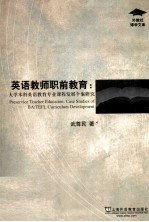图书介绍
英语教师职前教育 大学本科英语教育专业课程发展个案研究pdf电子书版本下载

- 武尊民著 著
- 出版社: 上海:上海外语教育出版社
- ISBN:9787544620109
- 出版时间:2011
- 标注页数:376页
- 文件大小:7MB
- 文件页数:193页
- 主题词:英语-语言教学-教学研究-师范大学
PDF下载
下载说明
英语教师职前教育 大学本科英语教育专业课程发展个案研究PDF格式电子书版下载
下载的文件为RAR压缩包。需要使用解压软件进行解压得到PDF格式图书。建议使用BT下载工具Free Download Manager进行下载,简称FDM(免费,没有广告,支持多平台)。本站资源全部打包为BT种子。所以需要使用专业的BT下载软件进行下载。如 BitComet qBittorrent uTorrent等BT下载工具。迅雷目前由于本站不是热门资源。不推荐使用!后期资源热门了。安装了迅雷也可以迅雷进行下载!
(文件页数 要大于 标注页数,上中下等多册电子书除外)
注意:本站所有压缩包均有解压码: 点击下载压缩包解压工具
图书目录
CHAPTER 1 INTRODUCTION 1
1.1 The Research Problem 1
1.2 Background 3
1.3 Significance of the Study 8
1.4 Definition of Terms 9
1.5 Organization of Thesis 10
CHAPTER 2 LITERATURE REVIEW Ⅰ: EFL TEACHER EDUCATION 12
2.1 Concepts and Issues in EFL Teacher Education 12
2.1.1 Teacher Training and Teacher Education 12
2.1.2 Theoretical Issues 13
2.1.3 Teacher Knowledge Base and Competencies 15
2.2 Development and Research 22
2.2.1 EFL Teacher Education Development 22
2.2.2 Approaches and Models 24
2.2.3 Research in Language Teacher Education 27
2.3 EFLTeacher Education in China 29
2.3.1 General Background Situation 30
2.3.2 EFL Teacher Education and Research 35
2.4 Summary 42
CHAPTER 3 LITERATURE REVIEW Ⅱ: CURRICULUM AND CURRICULUM STUDIES 44
3.1 Definitions 44
3.1.1 Curriculum 45
3.1.2 Goals and Objectives 46
3.1.3 Curriculum Organization 47
3.1.4 Curriculum Planning 50
3.1.5 Stakeholders 50
3.2 Curriculum Development 52
3.2.1 Curriculum Planning Process 52
3.2.2 Needs Analysis 57
3.2.3 Roles of Participants 60
3.2.4 Research 64
3.3 Evaluation 66
3.3.1 Concepts,Approaches and Procedures 66
3.3.2 Evaluation Research 68
3.4 Curriculum Studies in China 70
3.4.1 Teacher Education Institutions and Their Curricula 70
3.4.2 Studies in Curriculum Development 72
3.5 Summary 77
CHAPTER 4 RESEARCH METHODS 78
4.1 Research Design 78
4.2 Participants 80
4.2.1 Cases 80
4.2.2 Research Liaisons 82
4.2.3 Stakeholders 82
4.3 Instrumentation 85
4.3.1 Design of the Interview Protocols 86
4.3.2 Design of the Questionnaire 89
4.3.3 Documents 90
4.4 Data Collection Procedures 90
4.4.1 Case Site Visits 92
4.4.2 Interviews 94
4.4.3 Administration of the Questionnaire Survey 97
4.4.4 Collection of Documents 97
4.5 Data Processing Procedures 98
4.5.1 Processing Qualitative Data 98
4.5.2 Processing Quantitative Data 102
4.5.3 Modes of Analysis 102
4.6 Research Trustworthiness 103
4.6.1 Research Validity 104
4.6.2 Research Reliability 107
4.7 Research Ethics 108
4.8 Limitations 109
4.9 Summary 109
CHAPTER 5 FINDINGS OF CASE A 111
5.1 Profile 112
5.1.1 The University 112
5.1.2 The Department of Foreign Languages and Literature 114
5.1.3 The BA/TEFL Program 116
5.2 Curriculum Development Process 121
5.2.1 Regular Revisions 122
5.2.2 Ad hoc Adjustments 125
5.2.3 Other Factors Affecting Curricular Decisions 126
5.3 Curricular Structure 128
5.3.1 Curriculum Objectives 129
5.3.2 Curriculum Organization 130
5.4 The BA/TEFL Program: Perceptions of the Stakeholders 133
5.4.1 Program Heads 134
5.4.2 Teacher Educators 138
5.4.3 Student Teachers 142
5.4.4 Past Graduates 165
5.4.5 End-Users 188
5.5 Summary 193
CHAPTER 6 FINDINGS OF CASE B 197
6.1 Profile 198
6.1.1 The University 198
6.1.2 The Department of Foreign Languages and Literature 200
6.1.3 The BA/TEFL Program 201
6.2 Curriculum Development Process 206
6.2.1 Regular Revisions 207
6.2.2 Ad hoc Adjustments 209
6.2.3 Factors Affecting Curricular Decisions 210
6.3 Curricular Structure 213
6.3.1 Curriculum Objectives 215
6.3.2 Curriculum Organization 215
6.4 The BA/TEFL Program: Perceptions of the Stakeholders 219
6.4.1 Program Heads 219
6.4.2 Teacher Educators 221
6.4.3 Student Teachers 225
6.4.4 Past Graduates 247
6.4.5 End-Users 270
6.5 Summary 275
CHAPTER 7 CROSS-CASE ANALYSIS AND DISCUSSION 279
7.1 Process of Curriculum Planning and Development 279
7.1.1 Curriculum Processes 279
7.1.2 The Role of the Stakeholders 281
7.1.3 Possible Gaps 284
7.2 Comparison of the BA/TEFL Programs 289
7.2.1 Program Attributes 289
7.2.2 Curriculum Planning 292
7.2.3 Program Graduates in Teaching 298
7.2.4 Stakeholders' Perceptions of Preservice Preparation 300
7.3 EFLTeacher Knowledge Base and Competencies 302
7.3.1 Perceived EFL Teacher Qualities 302
7.3.2 EFL Teacher Knowledge and Competencies Perceived 305
7.3.3 Possible Gaps 307
7.4 Summary 308
CHAPTER 8 CONCLUSION AND IMPLICATIONS 310
8.1 Summary of Research Findings 311
8.1.1 Processes of Curriculum Planning and Development 311
8.1.2 Roles of Stakeholders in the Processes 312
8.1.3 Program Recipients' Perceptions of EFL Teacher Preparation 312
8.1.4 Secondary EFL Teacher Qualities and Competencies 315
8.2 Implications for BA/TEFL Curriculum Design and Development 316
8.2.1 Procedures 316
8.2.2 Program Goals and Objectives 321
8.2.3 A Framework for BA/TEFL Program Goals and Objectives 321
8.2.4 BA/TEFL Curriculum Organization and Implementation 323
8.3 Suggestions for Further Research 324
8.3.1 EFL Teacher Knowledge Base for China's Secondary Schools 324
8.3.2 An Integrated Curriculum 324
8.3.3 The Implementation of an EFL Teacher Education Curriculum 325
8.3.4 The Professional Development of Teacher Educators 325
References 326
Appendix A 340
Appendix B 344
Appendix C 347
Appendix D 350
Appendix E 353
Appendix F 356
Appendix G 368
Appendix H 370
Appendix I 373